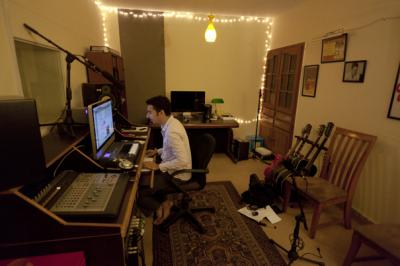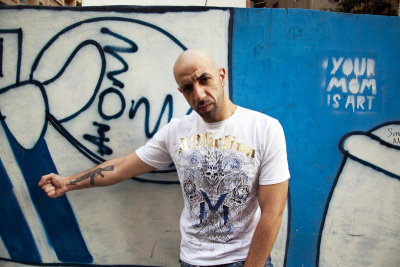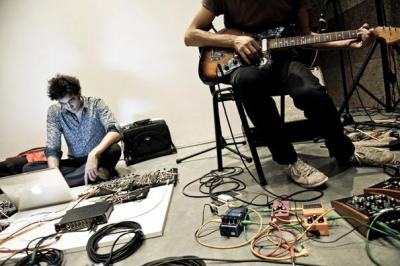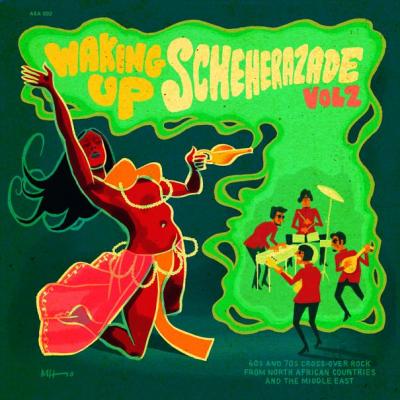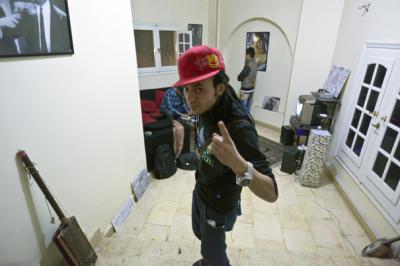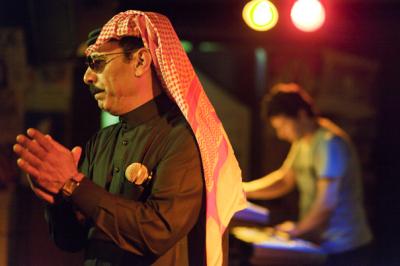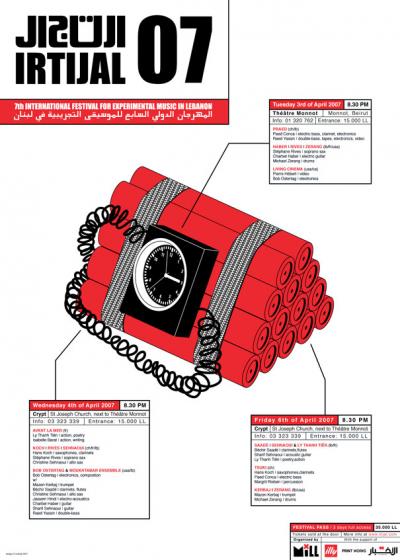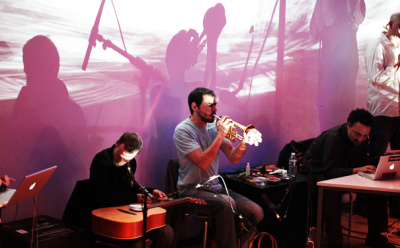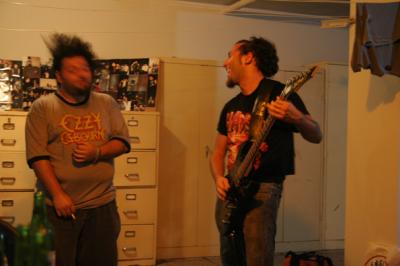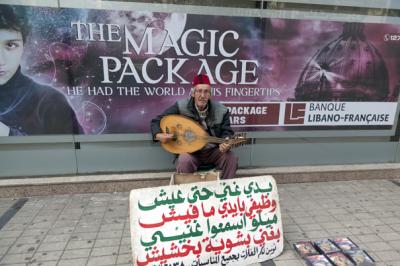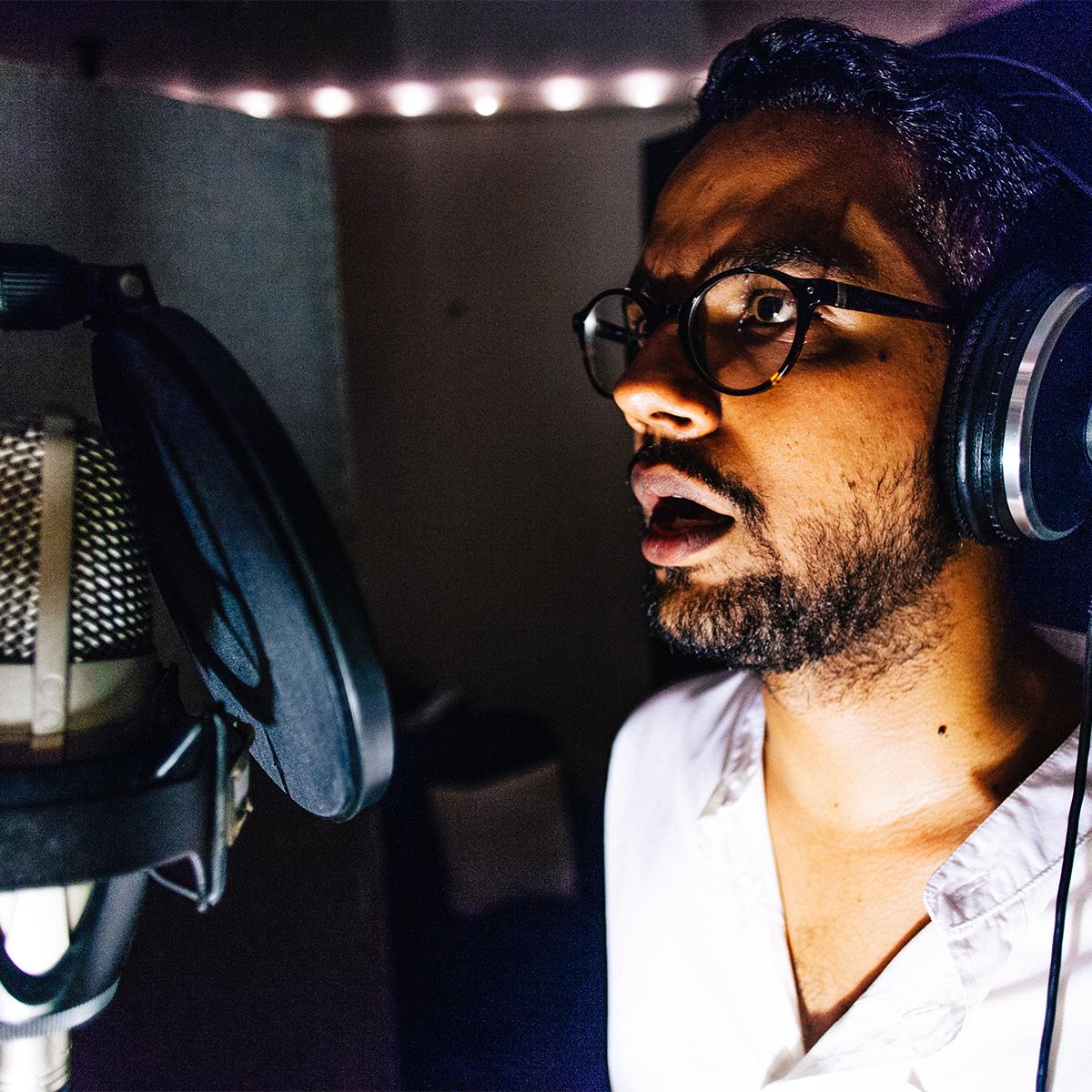The accelerated processes of globalization and digitalization have revolutionized music making on many levels. Austrian music sociologists Kurt Blaukopf (1996) and Alfred Smudits (2002) use the term media-morphoses to describe in detail major changes from the first recordings on cylinder phonographs to the advent of cassettes and CDs to the complete digitalization of musical production from the 1980s onwards. The digital media-morphosis alone continually brings revolutionary changes. Throughout the world, musicians find new ways to produce music at low cost and to promote it globally. Today’s music markets became a confusing mosaic of a million minimarkets and microstars. The geographical location of a musician, label, or distributor becomes a minor factor, it seems. Thomas Friedman (2005), among many others, highlights the newfound power for individuals to collaborate and compete globally. It is some of these individuals, musicians from the Arab World, that our audio-visual performance «Sonic Traces: From the Arab World» was about – and that our vinyl – and radio-mixes of it are about.
New Sounds from Africa, Asia, Latin America – and the Arab World
Musicians from Beijing to Tijuana, from Istanbul to Johannesburg, mix and manipulate local and global sounds and ideas within their music. They network with artists and multipliers (e.g., curators, producers, journalist, and scholars) worldwide and experiment with new ways of producing, distributing, and selling music. This recent music from Africa, Asia, and Latin America is progressively reaching Euro-American reception platforms and is being discussed by ethnomusicologists, popular music scholars, journalists, and bloggers with increased interest. Style-wise, the sample is broad: commercially successful styles of pop music like reggaeton (Marshall, Rivera, and Hernandez 2009) and kwaito (Steingo 2005; Swartz 2008), and electronic music styles like kuduro (Alisch and Siegert 2011), nortec (Madrid 2008), baile funk (Stöcker 2009; Lanz et al. 2008), shangaan electro, or cumbia electronica form the popular end of the spectrum. The experimental end offers African, Asian, and Latin American musique concrète, free improvisation, noise music, and sound art (e.g., Wallach 2008).
In the Arab world, we find a large number of upcoming musicians. On CDs (e.g., from the label 100copies and platforms like SoundCloud, we find them experimenting with the noises of Cairo and electronic music (e.g., Mahmoud Refat, Ramsi Lehner, Adham Hafez, Hassan Khan, Kareem Lotfy, and Omar Raafat). Using Casio PT minikeyboards, Kareem Lotfy and Omar Raafat mix noise with distorted, psychedelic-sounding Egyptian melodies. Mohammed Ragab – alias Machine Eat Man – works with analogue synthesizers. He defines his mixture of Arabic voice, flute samples, drums, psychedelic synthesizer movements, and electronics as «Egyptronica». Further, musicians range from pioneers like Halim El-Dabh to composers in Syria, rappers in Palestine, and metal musicians in Egypt. The list includes Nassim Maalouf with his «quartertone trumpet» and many other contemporary musicians (see Burkhalter, Dickinson, and Harbert 2013).
In addition, there are musicians of Arab origin in Europe and the U.S. who frequently network with musicians in the Arab world. Mahmoud Turkmani, a Lebanese musician and composer living in Switzerland, experiments with Egyptian takht ensembles, video art, and film. In his piece Ya Sharr Mout (Son of a Bitch), he harshly criticizes both the Europeanization of Arabic music and the extreme commercialism of Lebanese postwar mainstream culture.
Despite the many differences between these musical styles, some commonalities can be clearly identified: These musicians offer alternative musical positions and try to fight old «ethnocentric» Euro-American perceptions of their home countries in, for example, challenging and mixing up ideas about «culture», «place», «locality», «tradition», and/or «authenticity» in music.
In Europe and the U.S. not many years ago, small niche audiences listened exclusively to music from the Arab world, Africa, Asia, or Latin America. Specialists were primarily interested in Arabic maqam music and small Arab takht ensembles or sufi singers, whereas others were drawn to the famous Arabic singers Umm Kulthum, Asmahan, or Fairuz and Algerian or Franco-Algerian raï by Khaled or Cheb Mami (Schade-Poulsen 1999), or they listened to what is often referred to as oriental jazz, crossover, or world fusion. The latter include musicians like Rabih Abou Khalil, Anouar Brahem, and Dhafer Youssef, among others. This variety of music was (and is) often categorized as «world music» by record industries and media. British record producers invented it as a marketing label in the 1980s (e.g., Erlmann 1995, Taylor 1997, Mitchell 1996, Broughton 2006, Binas-Preisendörfer 2010), and the goal was to diversify the Euro-American market in order to sell more music. Consequently, to this day, «world music» is based on musical difference and otherness at its core. Due to this focus, the world music catalogue for the Arab world contains the music mentioned earlier, but few of the current rock, punk, metal, and electronic music, or electro-acoustic experiments and musique concrète, despite the fact that this very music has been produced not only in Beirut, but also in other Middle Eastern, African, Asian, and Latin American cities for many years. After a long period of nonrepresentation, musicians of these genres have now started to perform on various Euro-American reception platforms – with the help, support, and initiative of mostly small European and US-based producers and labels (some of them from within the world music networks).
Many new supporters of this emerging music ignored music from Africa, Asia, and Latin America for a long time – mainly because it fell into the category «world music». World music to them sounded «too cleanly produced», «too much of a middle-class taste», «too boring», or «too cliché» (interviews and discussions by author 1994–2013). Today, many authors of blogs, disc jockeys, and curators – the multipliers of the present – are considering a multitude of new and «trendy» terms to categorize these upcoming styles, for example, «global ghettotech», «shanty house theory», «worldtronica», or «ghettopop». In some of my articles I use the term «World Music 2.0» (Burkhalter 2010) – and I do so for various reasons. Many people – including me – hope that these latest tracks, songs, sound montages, and noises from the Arab world, Asia, Africa, and Latin America contain revolutionary meanings: That the old model of center and periphery is less valid than it ever was; that we are living in a world of multiple, interwoven modernities (Eisenstadt 2000). In other words, modernity emerges polycentrically through exchanges between the «global North» and the «global South» (Kolland 2010). We hope that these musics will support claims by social and cultural scientists that declare the one-sided theories of modernization to be unsound (Randeria and Eckert 2009). Whereas terms like «modernity», «global North», and «global South» are debated upon and deconstructed in academics, they are still in use in cultural networks and markets.
Multisited Modernities
In Beirut, musicians challenge Euro-American perceptions of the Arab world, the Middle East – and the world. They search «locality», «place» – or even «tradition» not in maqam based music or Arabic songs exclusively, but in the noises of Beirut; in specific media sounds and samples from present and past; and in Lebanon, the Arab world, and elsewhere. They approach taboos in manipulating the Lebanese Civil War and play with irony, sarcasm, and black humor. Peace is Overrated & War Misunderstood is one CD title of the punk and indie rock band Scrambled Eggs. Experimental musicians Cynthia Zaven and Sharif Sehnaoui meanwhile take A Minefield Bicycle Ride (2010). They provoke and confuse when stating in public that they have nostalgic feelings toward the Civil War. Is this pure provocation? Do they make fun of an outsider’s fascination with war? Or is what they express just a normal human reaction to one’s childhood? Certainly, their media performances are smart and challenging and far from black-and-white. Serge Yared confirms to me that his peers from Beirut love black humor and controversy: «Sometimes we work with images from war and violence because we know that it appeals to people outside. We can play a variety of roles.» Mazen Kerbaj speaks about possible interrelations between war memories and his music to a journalist in Berlin first. In other interviews, he denies this connection and states that he is just a free improviser. He and others enjoy negotiating between different roles. Tarek Atoui too knows that war is a good-selling argument. «Let’s take advantage», he says and laughs. «It’s only a joke.» He admits that he used to worry about benefiting from exoticism:
«I am who I am. I might have advantages, but also many disadvantages by being Lebanese. And I do not take profit in an easy way: I don’t mix beats with Oriental flavors, and I don’t put bombs directly in my music. War is not an argument to produce shit. We should not only moan or shout; we should try to do something different, and to create our own language out of our knowledge and our experiences. The best I can do is to produce music that is built in a serious way.»
Staging Exotica
Some musicians have rediscovered the appeal of «exotic» and «psychedelic» sounds. They are cocreating an international trend in today’s blogospheres (which is still dominated by Euro-American writers, DJs, and producers). These blogs (e.g., Wax Poetics, Awesome Tapes from Africa) – and labels, too – focus on non-Western popular music from the 1950s to 1970s. From the point of view of postcolonial theorists, and of many musicians from Beirut, this new celebration of exotica might be remarkable or even sobering at first hearing. For many of them, this long tradition of Western music looking for new exotic sounds and rhythms has a negative taste (see Locke 2009; Binas-Preisendörfer 2010; Taylor 2007; Born 2000). In European art music, composers like Claude Debussy (in Java), Béla Bartok (in Hungary), Leos Janacek (Czechoslovakia), and many others experimented with folk music traditions; in the genre of World Music (1.0), musicians and producers like Peter Gabriel, Ry Cooder, and Paul Simon performed with local musicians of other «cultures»; and in the 1980s, Indian and Pakistani music of second generation in the UK mixed sitar melodies and tabla rhythms with club beats. They portrayed their home countries not in a folkloristic but in a «modern» way (see Hutnyk, Sharma, and Sharma 1996; Zuberi 2001; Burkhalter 2000). «Have you ever sampled an Indian?» was one slogan on an Outcaste Records flyer that I collected in London in 1999. To my ear, however, they often reproduced old Indian music stereotypes, mixed them with drum ’n’ bass beats, and thus celebrated an essentialist multicultural hybridity. Often, in these projects, the beat serves as the «modern» downbeat (and basis), while the Indian singing – or the sitar playing – becomes no more than «pseudo-traditional» ornamentation. Jonathan Shannon calls this principle «theme and variation». He sees this ultimately as an imbalance in power: «Such an approach would merely reiterate in musical terms the idea that European modernity is a standard upon which other, alternative modernities are based» (Shannon 2006, 67). In Beirut, many musicians are very critical about this old formula. They try hard not to create «cheap fusion», they told me.
If these musicians stage exotica, they do so in a different way. They enjoy sounds and styles that fall outside the canon of official music history. Elites ignored this and referred to it as «tasteless», «noisy», «trash», «kitsch», or «cheap»: The harsh-sounding double clarinet mijwiz or its synthesizer adaptations in new wave dabké in Lebanon and Syria are two examples. In Egypt, «sha’abi» pop (Grippo 2010) – also called Electro-sha’abi oder Mahragan – is sometimes referred to as «low culture» or «street culture» – and in Egypt, experimental musicians from the 100copies label have begun to work with these street sounds, manipulating them with approaches from experimental music.
In Beirut, Raed Yassin focuses on music and songs from the belly dance culture of the 1950s and 1960s, psychedelic music of the 1960s and 1970s, Arabic pop of the 1980s, and new wave dabké of the 2000s. All these styles have the potential to anger cultured elites. Anne Rasmussen writes about the belly dance culture of the 1950 and 1960s:
«For the true connoisseurs of Arab music, those who performed and enjoyed music at community haflat, the music of the nightclub violated every boundary of authenticity. The nightclub sound was a musical hybrid generated by the creative invention and innovation of second-generation and post-World War immigrants who were inspired by modernization and Orientalism. Reflecting the influence of American popular music and the modern trends of Cairo, Egypt, musical innovators Muhammad al-Bakkar, Eddie ‹the sheik› Kochak, and Freddy Elias incorporated Western instruments and modern emergent styles into their performances during which a kind of musical caricature of the Orient was created.» (1992, 69)
It is this violation of «every boundary of authenticity» that Raed Yassin and many of his colleagues like. Egyptian musician Omar Khorshid is an idol to many, loved for his tremolo on the guitar, his 1960s psychedelic rock sound, and his kitschy (ironic-sounding) adaptations of holiday hits of the 1960s. This trend is transnational: American-Lebanese guitarist Sir Richard Bishop released the album Freak of Araby (2009), a tribute to Omar Khorshid. His brother Alan Bishop, who runs the Seattle-based label Sublime Frequencies, produced albums with collages from rare, obscure, and psychedelic-sounding samples from all over the world, for example, the CD 1970’s Algerian Proto-Rai Underground, compiled by Hicham Chadly.
Arabic pop from the 1980s is another focus of attraction, though it might offend supporters of advanced studio technology and music production:
«Most post-1980 albums have been produced quickly and comparatively inexpensively through studio overdubbing and extensive cutting-and-pasting (literally so, in the era of digital audio) of formulaic melodies, lawazim (melodic fills), harmonic sequences, texts, and forms, designed to burst (yitfar‘a’) predictably onto the scene, and rapidly fade. Trendy Western, Caribbean, and Latin sounds and styles (…) from rock to reggae, and especially the popular music ensemble featuring guitar, bass, drums, and org (…) introduced to the Arab world through the same media channels, have become increasingly prominent.» (Frishkopf 2010, 18)
New wave dabké offers a somehow similar but contemporary sensation to psychedelic music of the 1960s and 1970s, and to the early studio productions of Arabic pop. Contemporary dabké musicians control their synthesizers with small MIDI-boxes. They create the typical Arabian quartertones and imitate the shrill sounds of the double pipe oboe mijwiz, the traditional dabké instrument (Rasmussen 1996). In 2010, new wave dabké found a fan community outside its informal market of cassette tapes and MP3s. Syrian dabké singer Omar Souleyman produced several albums with indie label Sublime Frequencies and toured worldwide – supported by Raed Yassin. Pop star Björk – always on the search for new sounds – discovered Souleyman and remixed her song «Crystalline» (2011) with him. In a conference at SOAS London, BBC world music pioneer Charlie Gillett – shortly before his unfortunate early death in 2010 – expressed near indignation about Souleyman’s concert in London. He said that Souleyman was the worst wedding singer he had ever heard, a comment that Raed Yassin and others love. One can plainly state that the old, clear, and gentle world music has been attacked and replaced by new, «less pleasant» sounds.
These musicians work with «exotica» differently than generations of musicians before them. These musicians actively reveal the «exotic» presentations of strangeness and put it on the stage as a colorful, painful, or even traumatic play. Ethnomusicologist Veit Erlmann brings the differences to light. He defines the intercultural modus of World Music 1.0 with the term «pastiche», which he defines as a form of parody that lacks the polemical or satirical aspect. World Music 1.0 tries to highlight unspoiled musical forms and idioms. However, it mixes sounds of the completely commercialized present with the pseudo-historical patina of different places and time (Erlmann 1995:14). These musicians now have replaced pastiche with parody. They play joyfully with the Euro-American fetishizing and leitmotiving of the East. They often do so with an experimental music approach.
Staging War and Violence
Discussions around knowledge and experience become evident when the topic is war and violence. To stage war and violence is a transnational trend (e.g., Johnson and Cloonan 2008; Firme and Hocker 2006). M.I.A., the daughter-in-law of Warner Music CEO Edgar Bronfman, illustrates this very clearly on her 2010 album Maya. In the video of the track «Born Free», she presents herself as an activist and shocks the viewer with most radical violence. The video shows executions of many red-haired men – representative of prisoners in the civil war of Sri Lanka, as M.I.A. argues. The acoustic horror trip mixes sirens, explosions, screaming people, and noise; the voice of M.I.A. is manipulated to create the effect of a shouting dictator. Soon after the release of Maya, M.I.A. and her authenticity were criticized harshly. She uses provocation to attract attention and to sell more. Jamaican singer Terry Lynn is another example – among many: She promotes her album Kingstonlogic 2.0 with a big gun in her hand. Dancehall star Mavado is toasting over deep bass, gunshots, and dancehall beats.
My field research in Beirut too showed clearly the appeal of incorporating violence in music. Lured into stressing cultural differences on the Euro-American platforms, many musicians strategically focus on war and violence, or they use this link to their biography occasionally. One could argue that from an international perspective, these musicians have replaced one exotic element with another: traditional-sounding music for images and noises of gunshots and rockets. My research shows, however, that judging this is very delicate.
The musician with whom I discussed these issues the longest was Mazen Kerbaj, a trumpet player and cartoonist. Kerbaj is a main musician of the very active free improvised music circle that he started in 1997 along with Paris-based Lebanese musicians Christine Abdelnour and Sharif Sehnaoui. The three formed a trio, attracted more musicians, and created Musique Improvisée Libre au Liban (MILLS), an organization for free improvisation in Lebanon. They organize the annual international festival Irtijal (Improvisation) and launched their own label, Al-Maslakh (The Slaughterhouse), with the goal «to publish the un-publishable in Lebanon» (Kerbaj 2005).
The album brt vrt zrt krt t showcases Mazen Kerbaj as a solo artist. He is experimenting with distinct trumpet techniques and sounds—and using no software to manipulate them. His trumpet blubbers, jars, and claps from the deepest to the highest frequencies. In the track «Blblb Flblb», his trumpet is filled with water and thus creates deep bubbling sounds; it whispers softly and airily and screams in a high pitch. In «Zrrrt», he plays the trumpet with a tube. He sits on a chair, the tube around his neck and the trumpet between his legs. In «Taga of Daga», he uses a longer tube that is five meters. In «Tagadagadaga», he works with rhythmic patterns. Within each of the different tracks, there is little change, but we hear that Kerbaj controls those sounds, and we hear his rhythmic precision. It was the Austrian trumpet player Franz Hautzinger who told Kerbaj after a concert that Kerbaj’s trumpet in fact sounds very much like helicopters and rifles. This led Kerbaj to think about the relationship between the sounds of his childhood and youth and the sounds that he likes and creates now.
I had many debates on how the Lebanese civil war (or the current unstable situation) entered and continues to enter these musicians’ music and musicality. During my interviews, it seemed that most of the musicians remember the war similarly. Their sonic memories are full of propaganda music and speeches from the various militias, radio ads, and jingles, plus the sounds of rifles and bombs. The musicians argue that they know all the weapons of war just by listening to their sounds, and that they can tell from where to where a rocket flies, and whether or not a weapon is of direct danger to them. Their ears were shaped by around two hundred radio stations that constantly informed listeners about who had been killed, and which streets were open to traffic and which were not. According to them, the ear played an important role in the war. In my many interviews, absurd and often very cynical questions full of black humor were raised: «Is war good ear training?» Or, «Can listening to the weapons of war replace musical solfège?»
Today, Kerbaj believes that his sonic memories determine, to a certain extent, which sounds he likes or dislikes. «I have, for example, a very special relationship to silence», he says. «I was always afraid of silence. In silent moments we were always afraid of something worse to come» (Kerbaj 2005). On the other hand, Kerbaj states clearly that his musical taste and perception keep changing, through listening, musical education, and practice. Kerbaj identifies, as his main influence, the free improvised music scene in Europe. It seems clear that his attention to silence has also been nurtured by music history – first and foremost through composer John Cage’s discussions about silence and his silent piece «4'33». Other main influences, Kerbaj argues, are the pioneers of free jazz, for example, Peter Brötzmann and his album Machine Gun – Automatic Gun for Fast, Continuous Firing (Kerbaj 2006). Within and just after the 2006 Israel-Hezbollah war, many of the musicians showed a certain fascination with conflict (see Burkhalter 2013), similar to Italian futurist Luigi Russolo and his 1913 manifesto The Art of Noises (Russolo 2005) and the futurist writers around Filippo Tommaso Marinetti. This fascination seemed nurtured, however, by the personal experience of civil war in the first fifteen years of their lives (Burkhalter 2013) and not necessarily by a regard for war as an aesthetic and mythical phenomenon, as it was for the futurists (Witt-Stahl 1999).
Garo Gdanian from death metal band Weeping Willow in Beirut becomes very angry when one asks him about this fascination. «War is horrible; people die in this shit», Garo tells me. «War sucks! It’s not cool!» At the same time, Garo argues that his band renders «violence» and «war» more authentically and with more knowledge than metal bands from Europe and the U.S. – because the members of Weeping Willow have experienced war and the others have not. The irony, however, is that U.S. bands like Morbid Angel sound much more aggressive on CD than Weeping Willow does. Morbid Angel recorded in a better studio, with more time and money and a better sound engineer. The fact that Weeping Willow was not able to do the same is a long-term effect of the Lebanese Civil War.
Some Lebanese musicians describe their transnational networks as «taste» communities, but not always as «knowledge» communities. They share «taste» for kitsch and «trash», but they do not have the same knowledge of the specific material with which they are working. They are critical of «superficial» renderings of «war», «violence», and «exotica». Serge Yared brings in a typical argument for judging such experiments. He tells me:
«The role of an artist is to offer critical depth and to seeing everyday issues from a different angle. So when we work with the topic of war, we try to show it from personal, maybe not so known perspectives. I’m always a bit angry when I see these superficial references to war.»
World Music 2.0 or Multisited Avant-Garde?
The smartest and most successful musicians from the Arab World move in between two theoretical categories: World Music 2.0 and multisited avant-gardes. They work on various platforms simultaneously: They play rock or free improvisation within their transnational niche genres, in small clubs for little money, and they introduce new and old representations of exotica, war, or violence in big arts biennales, theme events (e.g., on the 2006 war, the Arab spring), or world music festivals.
They clearly cocreate multisited avant-gardes when playing with Euro-American expectations and render «localities» in challenging ways – similar to musicians of their generation worldwide. Their focus on irony and sarcasm, on noisy to kitschy sounds, stands in contrast to clean multicultural music. They live in a chaotic, noisy, and violent world, one that goes through rapid change toward an insecure future. The music of these multisited avant-gardes is its soundtrack.
At the same time, these musicians know too that exotica and war sell. What is obscure, ironic, and exotic does benefit disproportionately from the avalanche effect of the virtual commendations passed on from person to person on platforms like Facebook. One can thus understand their staging of exotica as strategic essentialism, too. They walk a thin line – between creating challenging positions and offering what works on transnational platforms. «Starry Night», Mazen Kerbaj’s recording of trumpet sounds with bombs of Israeli warplanes, pushed Kerbaj’s international career enormously – even though he is self-critical about his recording today and claims that he produced it under heavy emotional stress.
From a Euro-American perspective, music from Beirut – and from the Arab world, Asia, Africa, and Latin America – has the potential of coproducing multisited modernities. Musicians use the possibilities of digitalized music production, distribution, and reception for a more individual and manifold production of music. They construct confident postcolonial positions and form (finally and distinctly) a new multisited avant-garde of the twenty-first century. On the other hand, these musicians are still caught in the old postcolonial structures and dependencies, especially whenever they aim to reach Euro-American platforms. The ongoing processes of «othering», the focus on «diversity», «ethnocentrism», and «Orientalism» on Euro-American reception platforms still force them to constantly prove their «cultural» identity, their «Arabness» or «Africanness». This becomes clear in their ongoing focus on war, violence, and exotica. The musicians do, however, replace the «pastiche» (of World Music 1.0) with «parody». Overall, they adopt more or less successful artistic strategies. Through some of these strategies, their transcultural music can still stand as multisited avant-gardes; through others, it becomes «World Music 2.0». World Music 2.0 is a theoretical category and a provocative hint at the fact that there are still many boundaries to cross and stereotypes to break.
